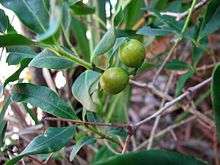Alyxia spicata
| Alyxia spicata | |
|---|---|
 | |
| Alyxia spicata with unripe fruit at Kewarra Beach, Queensland | |
| Scientific classification | |
| Kingdom: | Plantae |
| (unranked): | Angiosperms |
| (unranked): | Eudicots |
| (unranked): | Asterids |
| Order: | Gentianales |
| Family: | Apocynaceae |
| Genus: | Alyxia |
| Species: | A. spicata |
| Binomial name | |
| Alyxia spicata R.Br.[1] | |
Alyxia spicata, commonly known as chain fruit, is a sprawling shrub or vine in the family Apocynaceae. It is native to New Guinea and the Australian tropics.[2]
Plants may grow up to 4 metres high and have leaves in whorls of 4 on vertically growing shoots and whorls of 3 on horizontal shoots.[2] Flowers usually have an orange tube with cream lobes and are 3 to 4 mm in diameter with a hairy calyx. Fruits transition through yellow and orange and ultimately black upon ripening. These are around 10mm in diameter and may be joined like beads on a string.[2]
The species was formally described in 1810 by Scottish botanist Robert Brown in Prodromus Florae Novae Hollandiae, based on a specimen collected at Vanderlin Island in the Gulf of Carpentaria.[1] Plant material had earlier been collected at Cape Grafton and the Endeavour River during Lieutenant James Cook's first voyage of discovery in 1770 and illustrated by Sydney Parkinson.[3][4] An illustration of the species was published in 1900 with the name Gynopogon spicatum in Illustrations of the Botany of Captain Cook's Voyage Round the World in H.M.S. "Endeavour" in 1768-71.[5]
Alyxia spicata occurs naturally in rainforest, beach forest, vine thickets and on cliffs in New Guinea, the northernmost parts of Western Australia and the Northern Territory as well as north-east Queensland.[2][6] It is found at altitudes ranging from sea level to 1000 metres.[2]
References
- 1 2 "Alyxia spicata R.Br.". Australian Plant Name Index (APNI), IBIS database. Centre for Plant Biodiversity Research, Australian Government. Retrieved 27 August 2013.
- 1 2 3 4 5 Hyland, B. P. M.; Whiffin, T.; Zich, F. A.; et al. (Dec 2010). "Factsheet – Alyxia spicata". Australian Tropical Rainforest Plants. Edition 6.1, online version [RFK 6.1]. Cairns, Australia: Commonwealth Scientific and Industrial Research Organisation (CSIRO), through its Division of Plant Industry; the Centre for Australian National Biodiversity Research; the Australian Tropical Herbarium, James Cook University. Retrieved 26 August 2013.
- ↑ Jago, Bob. "Plants Collected by Banks & Solander in 1770 from North Queensland" (PDF). SGAP Queensland. Retrieved 27 August 2013.
- ↑ "Alyxia spicata". NMA Collections. National Museum of Australia. Retrieved 27 August 2013.
- ↑ Britten, James; Banks, Joseph; Solander (1900). Illustrations of the Botany of Captain Cook's Voyage Round the World in H. M. S. "Endeavour" in 1768-71. Longmans. Retrieved 27 August 2013.
- ↑ "Alyxia spicata". FloraBase. Western Australian Government Department of Parks and Wildlife.
External links
| Wikimedia Commons has media related to Alyxia spicata. |